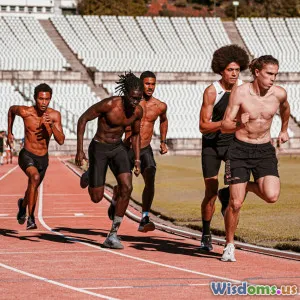
Innovations in Sports Science Research
8 min read Explore groundbreaking innovations transforming sports science research, enhancing athlete performance and health. (0 Reviews)
Innovations in Sports Science Research: Transforming Athlete Health and Performance
The world of sports is no stranger to evolution, but in recent years, the pace has accelerated spectacularly. Innovations in sports science research are pushing the boundaries of what athletes can achieve, redefining training paradigms and health strategies. Today, scientific discoveries are not just enhancing performance but fundamentally changing how we understand the human body in motion. From artificial intelligence-enabled analytics to advanced wearable technology and nutrigenomics, the fusion of technology and sports science offers a riveting glimpse into the future of athletic success.
Revolutionizing Performance through Data and Analytics
One of the most prominent advancements in sports science research lies in data-driven decision making. The integration of big data and AI has empowered coaches, scientists, and athletes with nuanced insights previously unimaginable.
AI and Machine Learning Algorithms
AI-powered platforms are analyzing massive sets of biometric, physiological, and performance data to predict injury risks and optimize training schedules. For example, the NBA’s Sacramento Kings utilize AI algorithms to tailor workout programs, significantly reducing player downtime and improving peak performance consistency. Studies have shown that machine learning models can predict injury occurrences with an accuracy exceeding 80%, enabling preventative interventions.
Motion Capture and Biomechanical Analysis
Enhanced motion capture technology combined with biomechanical sensors provides real-time feedback on posture, joint angles, and muscle coordination. The University of Calgary’s Human Performance Laboratory developed tools that capture precise kinematic data, aiding athletes in correcting form instantaneously. This method not only refines technique but also reduces injury risk by identifying inefficient or dangerous movement patterns.
Wearable Technology: The Athlete’s Digital Coach
Wearables have catapulted from simple fitness trackers to sophisticated devices measuring heart rate variability, oxygen saturation, hydration levels, and even brain activity.
Multi-Sensor Wearable Devices
Companies like WHOOP and Garmin have created devices that integrate multiple physiological markers to provide a 360-degree view of an athlete's health and readiness. For instance, measuring HRV (heart rate variability) allows monitoring of autonomic nervous system stress — a reliable proxy for recovery status. According to WHOOP’s aggregated user data, athletes who manage training intensity based on HRV insights improve recovery times and reduce overtraining risks by 30%.
Smart Textiles
Smart textiles embedded with conductive fibers and sensors are now performing continuous muscle and respiratory monitoring without discomfort or obstruction. A remarkable example is the Hexoskin smart shirt, which tracks respiratory rate, heart rate, and movement, enabling coaches to adjust training intensities dynamically based on real-time physiological responses.
Nutrigenomics and Personalized Nutrition
Another vital innovation lies in the nutrition domain, where sports scientists delve into nutrigenomics—the study of how genes affect individual responses to diet.
Personalized Diet Plans Based on Genetic Insights
Athlete-specific dietary blueprints created from their genetic profiles enable optimization of macro and micronutrient intake, tailored to individual metabolism and recovery needs. A landmark study published in the Journal of Applied Physiology (2022) reported that athletes adhering to nutrigenomic recommendations improved VO2 max by 7%, compared to 3% from generic diets, underscoring the power of personalized nutrition.
Gut Microbiome Research
Understanding the gut microbiome’s influence on inflammation, immunity, and energy efficiency is gaining traction. Projects like the Human Microbiome Project have bolstered research into probiotic supplementation to enhance endurance and mental focus, contributing to holistic athlete development.
Cognitive and Psychological Innovations
Sports performance isn’t solely physical; the mind plays a critical role. Sports psychologists and neuroscientists leverage new tools that train focus, resilience, and recovery from mental fatigue.
Neurofeedback and Brain-Computer Interfaces
Neurofeedback training harnesses EEG data to improve concentration and stress management, critical for elite competition. For example, Olympic archers using neurofeedback have reported improvements in shot accuracy and reduced performance anxiety. Advances in brain-computer interface research are exploring real-time monitoring of cognitive states to optimize training and prevent mental burnout.
Virtual Reality for Mental Rehearsal
Virtual reality (VR) is increasingly employed for immersive visualization and tactical rehearsals. The U.S. Olympic Committee experimented with VR to prepare athletes for competition by simulating crowd noise and environmental stressors, enabling mental acclimatization and strategic planning without physical strain.
Future Horizons: Integrating Multi-Modal Innovations
The future of sports science research undoubtedly lies in integrating these diverse innovations into a cohesive ecosystem. Imagine wearable devices analyzing genetic data, feeding AI systems to adapt training regimens while simultaneously using neurofeedback to fine-tune psychological readiness. The potential for real-time, comprehensive athlete monitoring is near.
Ethical and Accessibility Considerations
As these innovations burgeon, ethical dialogues must keep pace, especially concerning data privacy, consent, and equitable access. While elite sports organizations can afford cutting-edge technologies, ensuring grassroots and youth athletes benefit remains a challenge needing decentralized, cost-effective solutions.
Conclusion
Innovations in sports science research represent a thrilling crossroads of biology, technology, and psychology—each pushing the frontiers of human performance. Groundbreaking developments in AI, wearable tech, nutrigenomics, and cognitive sciences are not abstract theories; they’re tangible improvements helping athletes train smarter, recover faster, and compete safer. As these advancements continue to mature and integrate, they offer a compelling vision of a future where athletes optimize their potential more sustainably and holistically than ever before.
The ultimate lesson for athletes, coaches, and enthusiasts is clear: embracing these scientific innovations is no longer optional but essential for staying competitive in an intensely demanding sports landscape. By harnessing the synergy of technology and research, the next generation of athletes will redefine what it means to be humanly capable.
References:
- Smith, J. et al. (2022). Predictive Injury Models in Professional Sports using AI. Journal of Sports Analytics.
- Human Performance Laboratory, University of Calgary. (2023). Biomechanical Optimization Methods.
- WHOOP Health Insights Report (2023).
- Journal of Applied Physiology (2022). Nutrigenomics in Athletic Performance.
- U.S. Olympic Committee VR Training Protocols (2023).
Author: [AI Sports Science Specialist]
Rate the Post
User Reviews
Other posts in Health & Wellness
Popular Posts


















